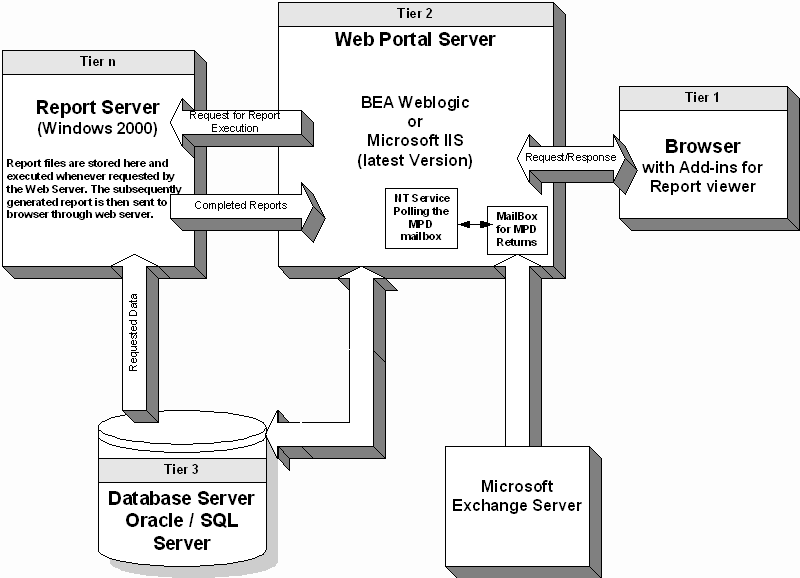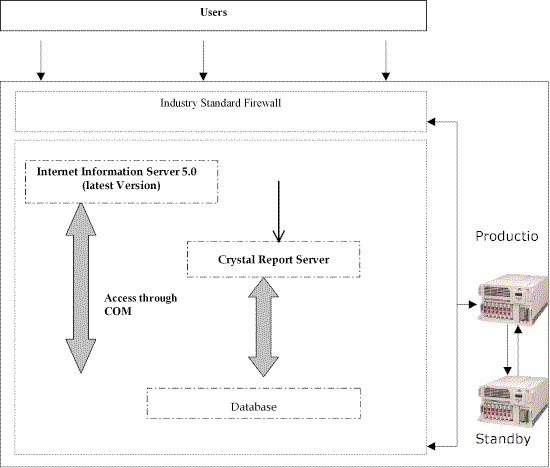 IST,
IST,
Request for Proposal (RFP) seeking Bidder Solution on Information Management Systems (IMS)
Reserve Bank of India
Monetary Policy Department
Reserve Bank of India (RBI), Monetary Policy Department (MPD), proposes to establish a database system to computerise its operations. This Information Management System (IMS) is expected to provide access to timely and uniform information to the department. This IMS system will be developed in uniform and standard package and will have the facility to receive/generate data/reports in bilingual form (English and Hindi).
This Request for Proposal (RFP) seeks Bidder solutions for the development and implementation of an IMS for the Monetary Policy Department. The contract will include a TWO year warranty and an Annual Maintenance of the System for a period of SEVEN years. The Annual Maintenance of the system may involve changes/updation/modification that would be required due to policy changes, etc.
Training will have to be provided to the staff of MPD, as System Administrators – 4 persons, Database Administrators – 6 persons and as users for 4-5 batches of 6 persons each.
The details of the proposed IMS and Proposal Requirements are appended.
Bidders satisfying the following eligibility criteria only need to apply.
- Bidder must be a registered corporate in India, registered under the Companies Act 1956, and having a minimum annual turnover of Rs.100 crore (Rupees hundred crore) or above.
- Bidder must warrant that it is financially solvent i.e. it is able to meet all its debts as and when they fall due.
- Bidder must have prior experience of having implemented a similar system in at least two or more major financial institutions in the last three years.
Eligible bidders may submit their proposal and other relevant documents to the office of the undersigned. It may be noted that the technical and commercial bids (two copies) may be submitted in separate sealed envelopes. One soft copy of the proposal may also be submitted in a sealed envelope.
Dr. D.V.S.Sastry
Adviser-in-Charge
Monetary Policy Department
Reserve Bank of India
Central Office, 24th Floor
Shahid Bhagat Singh Marg
Mumbai 400 001.
Sealed bids should be delivered on or before 3.00 p.m. on April 30, 2002. The technical bids will be opened at 4.30 p.m. on the same day. The bidders, if they so desire, may remain present during the opening of the technical bids. The financial bids will be opened at a later date only in respect of bidders whom the Reserve Bank finds suitable from the assessment of the technical bids.
Sd/-
(Adviser-in-Charge)
I. Proposal Requirements
Introductory Letter
Bidder/Applicants should provide a brief letter of introduction describing their understanding of the scope of work and their qualifications to undertake the project. The letter should specifically identify the names of all professionals who would be assigned to provide the services if awarded the contract.
General Requirement
All proposals should be prepared simply and economically, providing straightforward, concise descriptions of applicant’s ability to meet requirements of the IMS. Emphasis should be on completeness, clarity of content, responsiveness to the requirements and an understanding of the Bank’s needs.
Professional Experience and Qualifications
They must provide evidence of direct experience and qualifications to perform the requested services described in RFP – scope of consultancy. The Bank is interested in applicants’ direct experience in both Central Bank functioning and construction of such IMS systems. We suggest the inclusion of specific recent or current clients.
Applicant should state the names of all the individuals who will be assigned to the project. They must ensure that their experience gives a clear description of the extent to which individuals to be assigned to this project were involved in the referenced experience.
The Bank is particularly interested in qualifications, experience, track records and technical competence directly related to the scope of consultancy.
Please feel free to include any other information which will assist the Bank in assessing the extent to which the applicant has the professional experience, track record and technical competence to execute the project successfully within the given time frame. The success rate of execution of last 3-4 major projects may also be indicated.
Price
Applicant is required to provide a fixed fee for the entire scope. In addition, a full breakdown of cost and how they are derived – by unit of work or as a single job; inclusive or exclusive of reimbursable expenses; taxes and mobilisation costs – will be required. Details of any equipment and facilities required from the Bank in carrying out the project may also be indicated.
Charges, if any, for maintaining the system during warranty period (two years) and also the charges for Annual Maintenance for seven years may be indicated separately.
Additional Elements
- Provide information on your company such as size, structure, years of operation, financial performance, growth rate, etc.
- Profiles must be submitted for each professional working on the project.
- All costs incurred in the preparation and possible presentation of the proposal shall be the responsibility of the applicant.
- Proposal must be signed by duly authorized personnel.
All information in the RFP must be treated as confidential.
Acceptance of a proposal does not obligate the Reserve Bank of India in any manner. The Reserve Bank of India reserves the right to reject any or all proposals without assigning any reasons.
Source code developed for the System will be the sole property of Reserve Bank of India.
Applicants whose proposals best meet the requirements may be invited to meet representatives of the Reserve Bank of India for further discussions.
Clarifications regarding the request for proposal should be directed to Mr. N.S.Rawat – Telephone No. (022) 2661602 ext. 2298;.
In case, the applicant desires to peruse the SRS reports, the same will be made available in the Bank.
Evaluation Criteria
Proposals will be evaluated by the Technical Committee formed for the purpose by taking into account the following factors:
- Demonstrated understanding of requirements.
- Experience with similar projects
- Specific experience and qualifications of proposed staff
- Completeness of proposal
- Projected timeframe for completion of project
- Project cost
Reporting and Working Arrangements
The applicant shall describe the methodology for reporting the progress of the project.
Procurement of Hardware/Software
The applicant will assist this Department in procuring appropriate Hardware and required system Software.
Data Migration
The applicant will migrate the existing data which is mostly in Dbase files and Excel worksheets into proposed system’s database (Oracle). The approximate size of the existing database is 200MB.
Time Schedule
The project has to be completed within three months from the date of acceptance of the offer.
II. Proposed Information Management Systems (IMS)
The Monetary Policy Department (MPD) proposes to establish a database system to computerize its operations. This Information Management System (IMS) exercise is expected to provide their analysts, functional staff and management extensive access to timely and uniform information.
The present systems are mainly on standalone PCs and have the following limitations:
- In most of the cases, the input to the system is by manual data entry.
- In many cases, the different data storages have many common fields.
- Most of the data are stored on stand-alone PCs.
- There are no clearly identified user profiles with specific defined access rights.
- Data storage is in spreadsheets as well as in dBASE.
A System Requirement Study (SRS) for developing an integrated data processing and information management system in a fully computerized environment to meet the functional requirements, as identified and mutually agreed by MPD has already been done by consultants appointed by MPD. The consultants have submitted the following three main documents:
1. Application Requirement Specification (ARS)
The document details the working of MPD, the flow of information within and outside the organization and study of the various modules and procedures that are currently operational. It also has the future business requirements of MPD, as expressed by the Users.
2. Function Specification Document (FSD)
This document contains an exhaustive list of all that is expected of the new system after it is put in place. It provides details of various issues that are essential for software design. The FSD details various operational procedures and interfaces with other systems in the organization. The FSD also contains the logical design of the system, the system architecture and the Entity Relation Diagrams.
3. Hardware/software document
The hardware/ software specification document details the minimum software and hardware configuration, and includes the details of other integral sub-systems for the proposed system duly taking into account the security consideration, data migration, users privileges and system recovery & back-up procedures.
These documents along with the ER diagrams, Data flow diagrams and report layout will form the basis of the new system, which is proposed for the Department.
Scope of the System
All the six divisions of MPD have specific functions to be performed, a summary of which is annexed. The functions of these divisions that would be supported by the proposed system are listed in the table below. Apart from these functions there are some typical system features like parameterized reporting system, email notification, role based access etc. would also be supported in the proposed system.
Resource Management Division |
|
Selective Credit Control |
|
Monitoring Cash Reserve Ratio / Statutory Liquidity Requirement |
|
Qualitative feedback on Resource Management |
Planning and Monitoring Division |
|
Monitoring Broad Money and Reserve Money |
|
Assessing Consumer Price Index, Wholesale Price Index and Index of Industrial Production |
|
Monitoring flow of funds to commercial and corporate sector |
|
Assessing Loans and Balances in foreign currency |
|
Monitoring Banking System indicators |
Interest Rate Division |
|
Analyzing interest rates on different types of Bank Credits |
|
Analyzing interest rates on different types of Bank Deposits |
|
Analyzing interest rates on Commercial Papers and Certificates of Deposit |
|
Research on the prices or rates in the government securities markets, especially in the primary or auction markets |
Money Market Division |
|
Monitor Money Market Rates and participation of the Banks/FIs/PDs/Mutual Funds and Private companies in the financial Market in the form of Call/Notice and Term Money |
|
Monitor the liquidity support by RBI, Repo and Reverse Repo Auction, Liquidity Adjustment Facility and also the cumulative cash balance of RBI |
|
Monitor and track Export Credit Refinance availed by banks |
|
Monitor resource mobilization by Financial institutions through term money/CPs/CDs/term deposits/ICDs |
|
Monitor and analyze Forward Rate Agreement / Interest Rate Swaps contracts carried out during a given fortnight |
|
Monitor and analyze the investments in short term instruments |
At a broad level, this application will be run on a MS Windows 2000 server, using Oracle 8i as the database server. The reporting tool proposed is Crystal Reports and Active Server Pages (ASP) as the front end tool. The information delivery will be through standard web browsers like Internet Explorer or Netscape Navigator.
System Features
A. System Architecture
As mentioned earlier, MPD currently has all the applications and data on standalone systems. Therfore, there is a basic need to give a robust architecture that would include a central database having role-based access to data. The following block diagram depicts the system architecture of the proposed system, which would be a typical web based Information Management System.
MPD receives information from various sources. Some of them are departments of RBI like, DEAP, DBOD,etc., and other external sources are Banks, Financial Institutions, Primary Dealers, Private Companies and Mutual Funds. The inputs that come from these sources would be automated using the Mail Service with inbuilt validation features. Every automated input will be supported by manual data entry facility in the IMS application. This data will be stored into some secured RDBMS.

The input data would then be processed to generate reports. The standard reports will be stored in the report server. When the user click on the URL for the report, a request should be sent to the Web server, which then would make a request to the Report Server. The Report server would retrieve the report and the data from the Database Server and would return it to the Web server. The report and the data would then be displayed in the browser.
Input Automation
There will be a dedicated mailbox for MPD wherein all the inputs would be posted. This mailbox can be set up on the Web Server. All the inputs would have a standard format and some header that would identify the form name and the source. The input form templates would be available on the RBI website. The input formats should also be made compatible with message format of Structure Financial Messaging Solution (SFMS) adopted by the Bank. The Windows 2000 service would extract the data from the mail and after validating the authenticity of the input, it would insert the data in the appropriate data stores. The basic assumption is that all the banks would be using only the standard format to send the data. Any alterations made by banks would cause the Windows 2000 service to reject the data altogether. In such a situation, a mail will be sent to the sender of the rejected data with a copy to System Administrator of MPD, stating that data was sent in incorrect format and needs to be resubmitted after downloading the correct template of the return from RBI web site.
Email Notification
All the returns that come to MPD have different frequencies like, daily, fortnightly, monthly, quarterly and annually. The data regarding the frequencies will be stored in a data store. Normally all these returns arrive at MPD with some time lag and then the concerned division would keep on sending the reminders to defaulter banks. These reminders are sent to the concerned person in banks through phone calls. In the proposed system, there will be an option to generate the defaulter’s list. Whenever the user clicks on the option an option screen will come up. Here, the user will have to select the Return for which the defaulter’s list is to be generated and also the date when the return was expected. After the list is generated, the user will be given an option to send an email to the defaulter banks. Some advanced features like sending the SMS message on Cell phone can also be provided.
In case of the Daily Returns on Call / Notice / Term Money, this email notification can be automated as the delay cannot be tolerated in this system. Here some time limit can be fixed till which banks can send the data and after this the system will automatically keep on sending the reminder mails at fixed time intervals. There can be an escalation process, which can be defined. If the bank fails to send the data even after sending 2-3 reminders then automatically an SMS message can be sent to the concerned person.
Reporting Tool
The existing system either uses MS Excel for generating reports or Standard Dbase reports. The Report generation in the proposed system would have two categories. The standard reports and the ad hoc reports. The stored reports will be designed and uploaded during the implementation. All these reports would have the option screens wherein the users will be able to provide the required parameters and generate the reports accordingly. In general, these parameters would include the ability to generate the report for individual bank or for all the banks of particular category or subcategory. It can also include different date ranges for calculating the variation. These options would be ‘report specific’ and they are described in detail in the annexure giving the Report layouts in the SRS.
The second part of the reports is to be able to get some ad hoc report. For this, the system would have a customized Query Builder. Here, the user will be provided with the list of Entities. Whenever a particular Entity is selected, list of its attributes will be available to user. Out of these attributes, the user would select the attributes, which are to be displayed and also construct the conditional expression for the report.
The reporting tool would also give the facility to view some of the reports in the form of charts. And in general, users will be given the option of converting the reports into Excel format. In every report, there will be facility to send the report as an attachment through the application itself.
Express Data Entry Operation
Automation of the input is one way to accelerate the data input process. But in many cases, the manual data entry might be essential. In order to speed up the manual data entry process, the new system would provide with an option to copy the data from some earlier fortnight. This would mainly help in case of the return where only some of the data undergo change over a period of time like interest rates. Interest rates might remain constant for number of fortnights. This feature would help the manual data entry in a greater way.
Audit Trail
A suitable Audit Trail mechanism should be provided.
Security, Data Backup and Virus Protection
The data coming to MPD is sensitive and so the system dealing with this data should be extremely secured. The security would have multiple dimensions.
All the servers would be physically located at some place where the access will be limited only to few concerned people. As the new system is based on the RDBMS, it would have the role-based access to the data. There will be some defined privilege classes through which there will be controlled access to the database which could be defined up to the table level. Some of the critical tasks like creating new tables and dropping some of the existing tables should be kept only with the system administrator.
There will be password based access to the application to stop the unauthentic access to system. There will be a restriction on the password, which would make it difficult to be hacked. The restriction can be something like the password should be at least 8 characters long, password should be a combination of alphabets and numeric values, password should have at least one alphabet in caps, etc. In addition to this there should be a defined duration after which the users are compelled to change the password. There should be restriction on the number of wrong attempts to login like if a user tries to login using a wrong password consecutively for three times then his login should be locked. Only the system administrator can release locked account.
Apart from the malicious human access it is equally important to protect the system from physical damages. For this, it is necessary to take the regular backup of the data on the magnetic tapes/cartridges. Also, facility for keeping and regular updation of off-site backup of the data and application/system software, as a disaster management measure, should be provided.
In this system the input automation would be using E-mail as the main medium for data input, so it becomes extremely important to take care of the virus attack. For this every mail coming to MPD mailbox should be scanned for virus using the latest anti virus. In addition to this every workstation would have the latest anti virus installed.
This system will not act as input to any other system. Also all the inputs coming to system will either come through the exhange server as e-mail or will be entered manulally using the data entry screens. Hence, this system is not interefaced with any external system other than the Exchange Server. The data automation through mail server will be taken care of by the Windows 2000 service, which would poll the exchange server. On the arrival of the mail, it would run the respective validation routines and finally store the data into database.
Details of the Proposed System
System |
Number of Entities |
Number of Reports |
Selective Credit Control |
5 |
4 |
RMD- I to VIII |
11 |
16 |
CRR & SLR |
8 |
13 |
Section 42 |
9 |
9 |
SFR VII |
5 |
7 |
SFR VIII |
4 |
6 |
CPI – WPI |
4 |
10 |
IIP |
3 |
2 |
Money Supply |
4 |
9 |
SFR IIID |
9 |
18 |
SFR VI A |
7 |
5 |
SFR VI B |
8 |
6 |
ECR |
9 |
7 |
Call Money |
8 |
9 |
FRA/IRS |
4 |
4 |
System |
Number of Entities |
Number of Reports |
SCR |
5 |
3 |
Institution Admin |
6 |
|
Login System |
2 |
|
Rejected Input Tracker |
3 |
|
Login Audit |
2 |
|
Intruments/deposits Admin |
2 |
|
Policy Admin |
2 |
|
The logical architecture of the Information Management System

A Summary of System Requirement Study (SRS) Report submited by the IT consultant is as under :
I. System Architecture
- The proposed model should be a web-based system, which would facilitate centralised control of the system. The system will be an Intranet Web Application with n-tier architecture where Browser will be the Tier-1, Web Server acting as Tier-2, Database Server acting as Tier-3 and the Report Server playing the role of Tier-n.
- The Browser would be Internet Explorer 5.0 or above. The browser would carry an add-in called Smart viewer, which would be required for better formatted display on the client end.
- The Web server would take on the client request and the requested information would be supplied to the client as an HTML output or in form of report.
- The Report server would centrally store the reports. As and when the request is made for a report, fresh data would be pulled out from the report server and sent to the client.
- The Exchange server would collect "return form data" from various sources and store it in a dedicated Mailbox.
- There will be a dedicated mailbox for MPD wherein all the inputs would be posted . Every automated input will be supported by manual data entry facility in the IMS application.
- In the proposed system there will be an option to generate the defaulters’ list. After the list is generated the user will be given an option to send an e-mail to the defaulter banks.
- The audit trial feature would be available in the proposed system, which will inform when and who has created or modified the data.
II. Software
- The proposed system should run on MS Windows 2000 server using ORACLE 8i as the database server. The data will be stored into ORACLE database after validation.
- The reporting tool proposed is Crystal Reports. The report generation in the proposed system would have two categories, the stored reports and ad hoc reports. The standard reports will be designed and uploaded during the implementation and for ad hoc reports, the system will have a customised Query Builder. In every report there will be facility to send the report as an attachment through the application itself.
- The front end development kit will be Active Server Pages (ASP). ASP technology is well suited for Microsoft platform and it helps in faster development of the application because of the ease of use of ASP.
III. Hardware Platform
- The database server, web server and report sever are proposed to be run off the same box (machine) of the following configuration
1) 2 x intell Pentium III Xeon 2 x 900 MHz (2MB Cache) Server (Dual processor, scaleable to four processor) system with fibre channel storage system for no single point of failure and Microsoft Windows 2000 Advanced Server Operating System
2) A standby server of the same configuration as above, as a backup in case of failure.
3) For client systems, the minimum configuration of the PCs should be Intell Pentium II or higher at 500 MHz, 64 MB RAM or higher, 4 GB HDD, 10/100 Mbps PCI based 32/64 bit NI Cards, 1.44 MB FDD, monitor, etc. with Windows 98/NT OS running Internet Explorer 5.0 or higher version.
The client machines will be connected to the Web Server through the LAN connectivity. As all three servers, i.e., Report Server, Web Server and Database Server, would be kept on the same machine, the physical connectivity does not come into picture.
IV. Security and Privileges
- The data coming to MPD is sensitive and so system dealing with this data should be extremely secured. The security will have several dimensions and will be implemented over different levels.
- The system would ensure that the users follow login procedures.
- All the servers should be physically located at some place where the access will be limited only to few concerned people.
- The individual client machines would be governed by the LAN security system.
- The access to the database should be based on the role of the user in the organisation.
V. Recovery, Back up and Virus Protection
- As the proposed system would be web based, every mail coming to MPD mailbox should be scanned for virus using the latest anti virus software. In addition to this, every workstation should have the latest anti virus installed.
- The backup of the database should be taken on weekly incremental basis.
- Full backup of relational database data and source code file should be taken on monthly basis.
- A full backup should always be kept in a safe (off-site) location.
- A proper rotation of tapes/cartridgs should be done for optimum results.
- Facility for keeping and regular updation of off-site backup of the "data and application/system software", as a disaster management measure, should be provided.
VI. Data Migration
The systems in MPD uses either dBASE or Excel to store data and process it to generate reports, so the data migration would look into various aspects of migrating the data from these data stores to the proposed system models as per the following.
- The porting of data from dBASE would be done using the data transfer services of Oracle database.
- Considering the way in which data are stored in Excel data files, they are required to be cleaned first, then data to be arranged in proper formats, proper codes are to be given in various data fields, and then finally data transfer script can be written to pull the data from Excel files to Oracle.
For porting history data which is available only in registers/paper files, data entry would be the only option for which proper screens would have to be provided.
Functions of variuos Divisions of MPD
Division 1 - (Policy Co-ordination Division)
- Co-ordination with other departments/ Government/ outside agencies on policy issues, follow-up and clarification.
- Monetary policy meetings: arrangements - Coordination - Follow-up regarding circulars.
- Legal issues
- Parliament questions - supply of material for committees/ commissions instituted by Parliament/ Government
- Matters relating to DFHI
- Preparation of compendium of circulars
Division 2 - (Interest Rate Division)
- Bank Rate
- Monitoring of short term interest rates - Government
- Securities markets CPs, CDs, etc.
- Forex Market
- Deposit/lending rates
- Export credit interest rate
- Preparation of Memorandum to the Central Board and for senior officers meeting
- References regarding interest rates
- Supply of material to DEAP regarding (a) Bank's Annual Report (b) Report on Currency and Finance (c) Report on Trend and Progress in Banking.
- Supply of material for (a) Economic Survey (b) Finance Minister's budget speech (c) Annual Report of MOF.
Division 3 - (Resource Management Division)
- Resource management of banks
- Monitoring of compliance of CRR, SLR by banks and other fortnightly returns.
- References relating to Sec.24 of BR Act and Sec.42 of RBI Act.
- Sectoral deployment of credit
- Selective Credit Controls
- Computer unit
- Administration & Rajbhasha Unit
Division 4 - (Monetary Modeling Unit)
- Monetary Modeling
- Work relating to Standing Committee on International Financial Standard and Codes
- Any other work assigned by the top management.
Division 5 - (Money Market Division)
- Refinance facilities from RBI
- Money market development - policies, instrument development and institutional arrangements
- Matters regarding financial institutions, State Financial Corporations
- Preparation of statements regarding refinance, call/notice, term/money markets MMMFs, FIs, IRS, etc.
- Secretarial support to Standing Committee on Money Market
Division 6 - (Planning and Monitoring Division)
- Monetary Projections
- Liquidity assessment
- Preparation of policy notes
- Preparation of statements on banking/monetary aggregates
- Preparation of update, monthly developments, current trends
- Secretarial assistance to Monetary Strategy Group
ಪೇಜ್ ಕೊನೆಯದಾಗಿ ಅಪ್ಡೇಟ್ ಆದ ದಿನಾಂಕ:
ಪೇಜ್ ಕೊನೆಯದಾಗಿ ಅಪ್ಡೇಟ್ ಆದ ದಿನಾಂಕ:
ಪೇಜ್ ಕೊನೆಯದಾಗಿ ಅಪ್ಡೇಟ್ ಆದ ದಿನಾಂಕ:


















